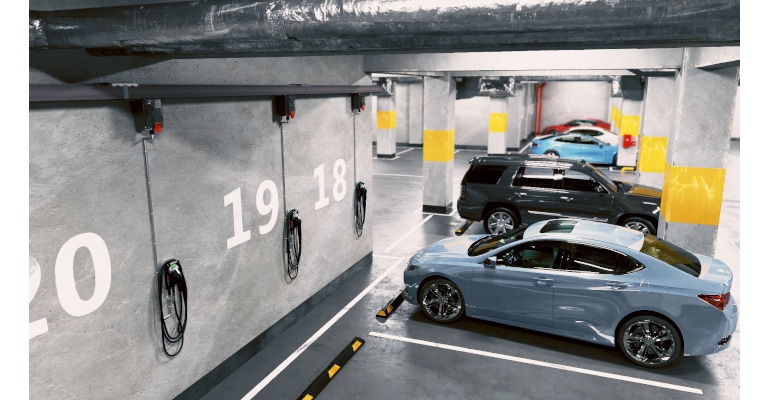The 'Power' of a Good Charging Station
Flexible, versatile, and accessible electric vehicle supply equipment is needed to meet the goals of the Infrastructure Investment and Jobs Act.

The United States plans to update its infrastructure significantly thanks to the Infrastructure Investment and Jobs Act, aka the bipartisan infrastructure bill. Last November, the U.S. Congress passed the landmark H.R. 3684, including $550 billion of new spending for roads, bridges, public transportation, ports, waterways, etc. This investment includes $7.5B for expanding a nationwide network of electric vehicle charging stations to address the challenge of supporting the massive increase of expected electric vehicles on the road in the United States.
The Biden Administration has set a goal of 500,000 public charging stations by 2030. In addition, the president’s ambitious plan also includes 50 percent EV sales in the United States by the same year. According to the Development of Guidance for Electric Vehicle Charging Infrastructure Deployment, “The recently enacted Bipartisan Infrastructure Law invests in the deployment of electric vehicle (EV) charging infrastructure as one of many important ways to confront the climate crisis. Through a National Electric Vehicle Formula Program (EV Charging Program), the law provides funding to states to strategically deploy EV charging infrastructure and establish an interconnected network to facilitate data collection, access, and reliability.”
The Nationwide EV Charging Station Challenge
According to the US Department of Energy, 46,709 alternative fueling stations are currently in the United States and Canada. The biggest challenge to rapidly expanding this number to meet EV charging station expectations is—scalability. The U.S. EV charging infrastructure must accommodate all charging use-cases and the predicted exponential market growth. The reality is that electric vehicle supply equipment (EVSE) must be able to upscale its networks to expand appropriately. How can this expansion ultimately be ensured? The answer resides in creating a flexible, interchangeable, and sustainable power system that feeds widely distributed charging stations.
Evgo, Blink, ChargePoint, Volta, Wallbox, and Electrify America (Volkswagen owned) are the well-known EV-charging network providers. Their business model is to maintain, build, operate or lease their equipment to businesses, individuals, and governments and then offer a subscription to vehicle owners who sign up. But to achieve a sustainable and reliable network, there needs to be a platform that supports flexible power implementation options.
After all, EV-charging providers currently deal with many challenges, from resource limitations within their IT operations and the need to support chargers from multiple vendors to integrating networks from acquired companies and pressures in getting to market quickly. That’s a lot.
Flexible EV Charging Solution
The good news: EVSE costs are trending downward. But transportation entities face additional issues in developing the EVSE network infrastructure. Big cities are an issue; commercial fleet entities don’t have adequate space to install EVSE pedestal ports. Most pedestal chargers have a minimal number of plugs that can be used simultaneously. Plus, they are inflexible to any future changes or reconfigurations due to their stationary structure. However, an alternative overhead system to distribute power, with a continuously open channel that allows instant access to electricity at any point along the busway, is a plausible solution to this dilemma.
New track busway systems provide commercial fleets with the flexibility for power reconfiguration, enabling a reliable point-of-use power source to support a variety of EV chargers and maximum space savings. They offer a wide range of amperages and a variety of solutions from 100 to 1200 amps. In addition, this type of overhead busway offers:
Optimal voltage and ampacity on a mass scale.
Customized plug-in units that are accessed instantly at any location provide the specific power needs at the point of use.
An overhead solution that eliminates numerous panels and long runs of pipe and wire.
Revenue-grade metering options for power monitoring and load balancing.
Quick installation and easy expansion to accommodate future capacity.
Conclusion
Electric vehicles are here now—they are not a future concept. As EVSE networks continue to transform, innovative solutions phase out costly and outdated technology. Commercial and consumer demand calls for scalable, reconfigurable charging systems to maintain a competitive advantage in a quickly changing market. The global automotive industry is now led by forward-thinking companies and institutions, which is a big step in the right direction. An equally innovative EVSE infrastructure will be needed for electric vehicles to reach their full potential. The Infrastructure Investment and Jobs Act will be beneficial for expanding EV charging stations. Still, there is a lot of work to do on the charging infrastructure first—it needs to be versatile with the ability to monitor power feeds.
About the Author(s)
You May Also Like



